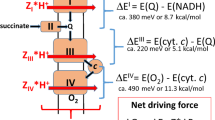Abstract
INHIBITION of respiration by azide has been known for many years. It is now generally considered that azide not only inhibits electron transfer through the cytochrome chain, presumably by inhibiting cytochrome oxidase1,2, but that it also inhibits one of the associated reactions involved in the production of ATP (refs. 3 and 4), The reactions of phosphorylation seem to be more sensitive to azide than the electron transfer reactions because smaller concentrations of azide are required to inhibit oxygen uptake in the presence of ADP and inorganic phosphate than in their absence5,6, that is, state 3 respiration is more sensitive to azide than state 4 respiration.
This is a preview of subscription content, access via your institution
Access options
Subscribe to this journal
Receive 51 print issues and online access
$199.00 per year
only $3.90 per issue
Buy this article
- Purchase on Springer Link
- Instant access to full article PDF
Prices may be subject to local taxes which are calculated during checkout
Similar content being viewed by others
References
Keilin, D., Proc. Roy. Soc., B, 121, 165 (1936).
Yonetani, T., and Ray, G. S., J. Biol. Chem., 240, 3392 (1965).
Loomis, W. F., and Lipman, F., J. Biol. Chem., 179, 503 (1949).
Slater, E. C., Biochem. J., 59, 392 (1955).
Lehninger, A. L., and Gregg, C. T., Biochim. Biophys. Acta, 78, 12 (1963).
Wilson, D. F., and Chance, B., Biochem. Biophys. Res. Commun., 23, 751 (1966).
Lardy, H. A., Johnson, D., and MacMurray, W. C., Arch. Biochem. Biophys., 78, 587 (1958).
Wadkins, C. L., and Lehninger, A. L., J. Biol. Chem., 233, 1589 (1958).
Wadkins, C. L., and Lehninger, A. L., J. Biol. Chem., 238, 2555 (1963).
Lardy, H. A., Connelly, J. L., and Johnson, D., Biochemistry, 3, 1961 (1964).
Hodges, T. K., and Hanson, J. B., Plant Physiol., 40, 101 (1965).
Kenefick, D., and Hanson, J. B., Biochem. Biophys. Res. Commun., 24, 899 (1966).
Brierley, G. P., Murer, E., and Bachman, E., J. Biol. Chem., 238, 3482 (1963).
Kenefick, D., and Hanson, J. B., Plant Physiol. (in the press).
Stoner, C., Hodges, T. K., and Hanson, J. B., Nature, 203, 258 (1964).
Hanson, J. B., and Hodges, T. K., in Current Topics in Bioenergetics, 2 (edit. by Sanadi, D. R.) (in the press, 1967).
Lehninger, A. L., The Mitochondrion, Molecular Basis of Structure and Function (W. A. Benjamin, Inc., New York, 1964).
Author information
Authors and Affiliations
Rights and permissions
About this article
Cite this article
HODGES, T., ELZAM, O. Effect of Azide and Oligomycin on the Transport of Calcium Ions in Corn Mitochondria. Nature 215, 970–972 (1967). https://doi.org/10.1038/215970a0
Received:
Issue Date:
DOI: https://doi.org/10.1038/215970a0
Comments
By submitting a comment you agree to abide by our Terms and Community Guidelines. If you find something abusive or that does not comply with our terms or guidelines please flag it as inappropriate.



